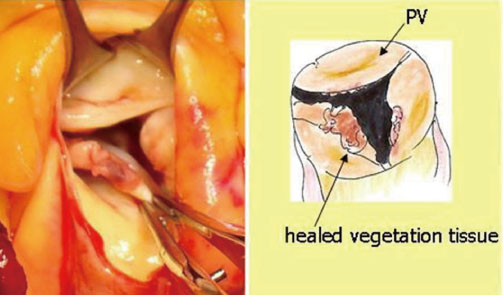Infect Chemother.
2010 Oct;42(5):311-314. 10.3947/ic.2010.42.5.311.
A Case of Endocarditis due to Granulicatella adiacens
- Affiliations
-
- 1Department of Internal Medicine, Gachon University of Medicine and Science, Incheon, Korea.
- 2Department of Laboratory Medicine, Gachon University of Medicine and Science, Incheon, Korea.
- 3Department of Thoracic and Cardiovascular Surgery, Gachon University of Medicine and Science, Incheon, Korea. cch624@gilhospital.com
- KMID: 1806896
- DOI: http://doi.org/10.3947/ic.2010.42.5.311
Abstract
- Granulicatella species are nutritionally variant streptococci first described in 1961. Granulicatella species form a part of the normal flora of the oral cavity, genitourinary tract, and intestinal tract. These micro-organisms cause bacteremia or local infections such as endocarditis, central nervous system infections, arthritis, and osteomyelitis. Since isolation of Granulicatella species is difficult, only a few cases of infection caused by this microorganism have been reported. Herein, we report a case of endocarditis caused by Granulicatella adiacens in a 46-year-old patient with ventricular septal defect.
MeSH Terms
Figure
Cited by 1 articles
-
A Case of Infective Endocarditis caused by Abiotrophia defectiva in Korea
Seohyun Park, Hea Won Ann, Jin Young Ahn, Nam Su Ku, Sang Hoon Han, Geu Ru Hong, Jun Young Choi, Young Goo Song, June Myung Kim
Infect Chemother. 2016;48(3):229-233. doi: 10.3947/ic.2016.48.3.229.
Reference
-
1. Collins MD, Lawson PA. The genus Abiotrophia(Kawamura et al.) is not monophyletic: proposal of Granulicatella gen. nov., Granulicatella adiacens comb. nov.,Granulicatella elegans comb. nov. and Granulicatella balaenopterae comb. nov. Int J Syst Evol Microbiol. 2000. 50:365–369.
Article2. Rosenthal O, Woywodt A, Kirschner P, Haller H. Vertebral osteomyelitis and endocarditis of a pacemaker lead due to Granulicatella (Abiotrophia) adiacens. Infection. 2002. 30:317–319.
Article3. Hepburn MJ, Fraser SL, Rennie TA, Singleton CM, Delgado B Jr. Septic arthritis caused by Granulicatella adiacens: Diagnosis by inoculation of synovial fluid into blood culture bottles. Rheumatol Int. 2003. 23:255–257.
Article4. Cerceo E, Christie JD, Nachamkin I, Lautenbach E. Central nervous system infections due to Abiotrophia and Granulicatella species: an emerging challenge? Diagn Microbiol Infect Dis. 2004. 48:161–165.
Article5. Riede U, Graber P, Ochsner PE. Granulicatella (Abiotrophia) adiacens infection associated with a total knee arthroplasty. Scand J Infect Dis. 2004. 36:761–764.
Article6. Chang SH, Lee CC, Chen SY, Chen IC, Hsieh MR, Chen SC. Infectious intracranial aneurysms caused by Granulicatella adiacens. Diagn Microbiol Infect Dis. 2008. 60:201–204.7. Altay M, Akay H, Yildiz E, Duranay M. A novel agent of peritoneal dialysis-related peritonitis: Granulicatella adiacens. Perit Dial Int. 2008. 28:96–97.
Article8. del Pozo JL, Garcia-Quetglas E, Hernaez S, Serrera A, Alonso M, Pina L, Leiva J, Azanza JR. Granulicatella adiacens breast implant-associated infection. Diagn Microbiol Infect Dis. 2008. 61:58–60.9. Lee SY, Pai CH. Two cases of nutritionally variant streptococci from patients with endocarditis. Korean J Clin Pathol. 1995. 15:273–280.10. Kwon O, Park SD, Uh Y, Yoon KJ, Kwon SO, Kim HY. A case of septicemia by Granulicatella adiacens. Infect Chemother. 2005. 37:368–371.11. Shin KS, Son BR, Jeong HW. A case of Granulicatella adiacens septicemia identified by 16S rRNA sequencing analysis. Korean J Clin Microbiol. 2008. 11:63–65.
Article12. Frenkel A, Hirsch W. Spontaneous development of L forms of streptococci requiring secretions of other bacteria or sulphydryl compounds for normal growth. Nature. 1961. 191:728–730.
Article13. Kawamura Y, Hou XG, Sultana F, Liu S, Yamamoto H, Ezaki T. Transfer of Streptococcus adjacens and Streptococcus defectivus to Abiotrophia gen. nov. as Abiotrophia adiacens comb. nov. and Abiotrophia defective comb. nov., respectively. Int J Syst Bacteriol. 1995. 45:798–803.
Article14. Brouqui P, Raoult D. Endocarditis due to rare and fastidious bacteria. Clin Microbiol Rev. 2001. 14:177–207.
Article15. Stein DS, Nelson KE. Endocarditis due to nutritionally deficient streptococci: therapeutic dilemma. Rev Infect Dis. 1987. 9:908–916.
Article16. Lin CH, Hsu RB. Infective endocarditis caused by nutritionally variant streptococci. Am J Med Sci. 2007. 334:235–239.
Article17. Jeng A, Chen J, Katsivas T. Prosthetic valve endocarditis from Granulicatella adiacens (nutritionally variant streptococci). J Infect. 2005. 51:e125–e129.
Article18. Perkins A, Osorio S, Serrano M, del Ray MC, Sarriá C, Domingo D, López-Brea M. A case of endocarditis due to Granulicatella adiacens. Clin Microbiol Infect. 2003. 9:576–577.19. Wilson W, Taubert KA, Gewitz M, Lockhart PB, Baddour LM, Levison M, Bolger A, Cabell CH, Takahashi M, Baltimore RS, Newburger JW, Strom BL, Tani LY, Gerber M, Bonow RO, Pallasch T, Shulman ST, Rowley AH, Burns JC, Ferrieri P, Gardner T, Goff D, Durack DT. American Heart Association. Prevention of infective endocarditis: guidelines from the American Heart Association: a guideline from the American Heart Association Rheumatic Fever, Endocarditis and Kawasaki Disease Committee, Council on Cardiovascular Disease in the Young, and the Council on Clinical Cardiology, Council on Cardiovascular Surgery and Anesthesia, and the Quality of Care and Outcomes Research Interdisciplinary Working Group. J Am Dent Assoc. 2008. 139:Suppl. 3S–24S.20. Soufflet V, Van de Bruaene A, Troost E, Gewillig M, Moons P, Post MC, Budts W. Behavior of unrepaired perimembranous ventricular septal defect in young adults. Am J Cardiol. 2010. 105:404–407.
Article
- Full Text Links
- Actions
-
Cited
- CITED
-
- Close
- Share
- Similar articles
-
- A Case of Septicemia by Granulicatella adiacens
- A Case of Granulicatella adiacens Septicemia Identified by 16S rRNA Sequencing Analysis
- Discrepant Satellitism for Identification of Granulicatella adiacens Isolates
- Infective Endocarditis due to Streptococcus pneumoniae
- A Case of Complete Heart Block Complicating Bacterial Endocarditis


